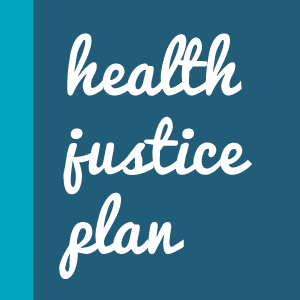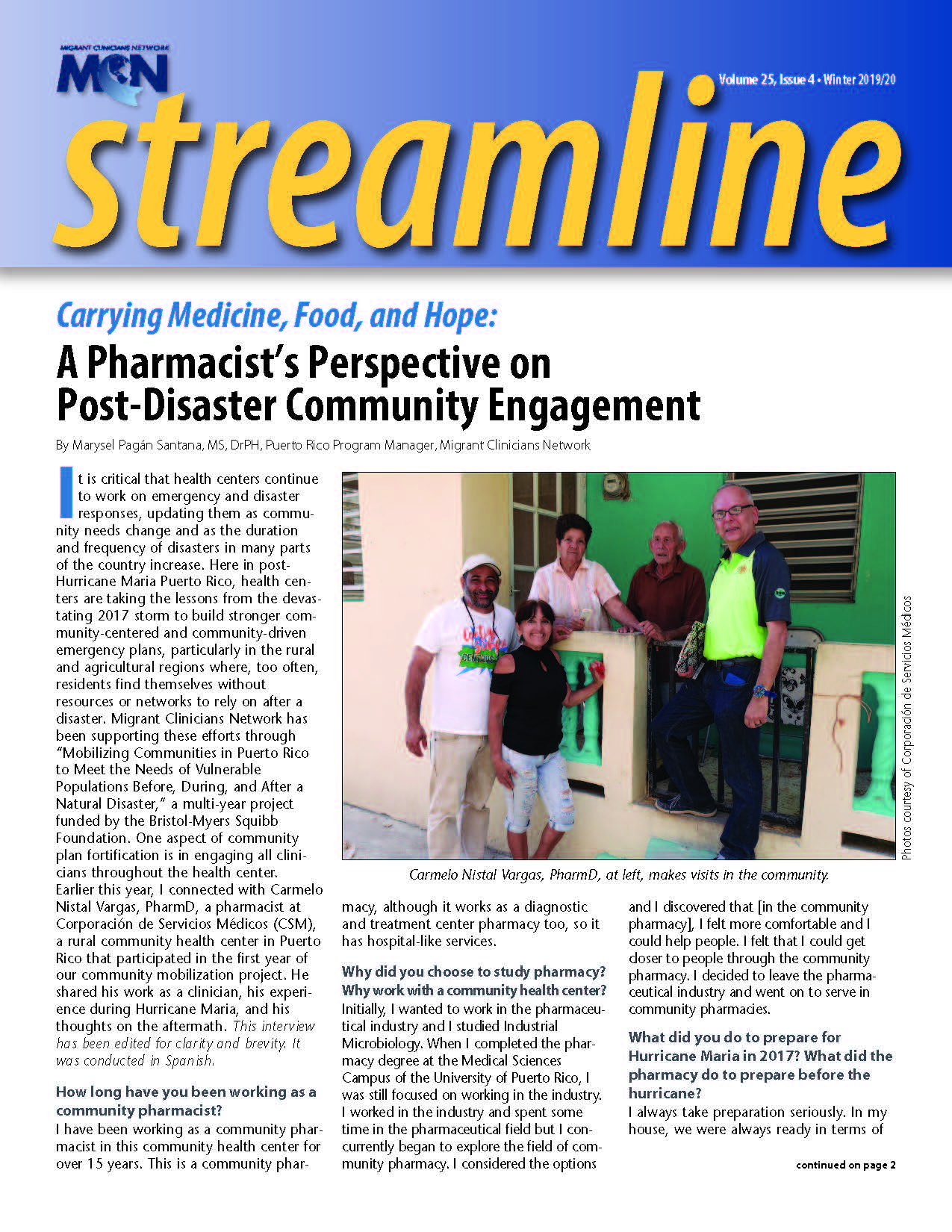- Who We Are
- Clinician Employment
- Publications
- Witness to Witness (W2W)
- Kugel & Zuroweste Health Justice Award
- Your Voice Matters: Photovoice Project
Resources
Close Resources⇧

By Claire Hutkins Seda, Writer, Migrant Clinicians Network and Managing Editor, Streamline
Clinicians are overwhelmed. But what exactly is fueling the emotional exhaustion? Clinician burnout, says Kaethe Weingarten, PhD, is just part of the problem, particularly in health centers motivated by a mission. Conditions in the workplace, like compacted patient schedules, lengthy performance measures, and frustration with electronic medical records are often cited as major factors in clinician burnout and they build up over time. The issue is so widespread that it has been declared an “epidemic” in newspapers across the country. Yet, Dr. Weingarten argues, what affects many clinicians is multifaceted. Mission-driven workplaces like health centers, seeking to serve those with few resources, may set the stage for burnout, as employees feel motivated or obligated to work longer hours or accept larger caseloads, to further the mission and not let patients down.
Layered on top of burnout is the trauma of caring for people who have experienced violence and violation. Secondary traumatic stress is an acute reaction to exposure to the story or client that experienced the primary trauma -- and it’s a common response among health care providers.
Just as troubling, but less recognized, is vicarious traumatization: “like burnout on a timeline,” Dr. Weingarten said in a recent MCN webinar for supervisors. “It doesn’t happen all of a sudden. It’s a slow, gradual process whereby exposure to trauma and the traumatic lives of the people that we work with really alter our worldview.” With vicarious traumatization, the world no longer feels safe; optimism fades.
These empathic responses to our workplaces pose the risk of real and lasting health concerns. “Moral injury” is a term often reserved for veterans, but Dr. Weingarten finds it useful in talking about the work of health care providers. “It has to do with what happens to us when we feel that we are working inside of systems where the systems themselves are failing to meet the needs of the people we deal with,” she said, wherein clinicians feel they are failing to consistently meet the needs of people they are serving due to inadequacies of the systems of which they are a part. “It transgresses their moral code,” she added.
In response to widespread moral injury, Dr. Weingarten developed Witness to Witness, a program to provide short-term support to clinicians and other helpers in high-stress jobs working with clients who are themselves experiencing high levels of stress and trauma. She and the American Family Therapy Academy (AFTA) partnered with Migrant Clinicians Network to offer the program, particularly for clinicians working on the border. Through Witness to Witness, volunteer therapists from AFTA speak via phone or video chat for several sessions to talk through what they have witnessed and how it affects their work. This year, the focus broadened, with a specific initiative for clinicians and other service providers who worked through the Camp Fire, the terrifyingly rapid conflagration that burned down Paradise, California, killing 86 people, injuring many more, and leaving tens of thousands of residents homeless.
In partnership with Migrant Clinicians Network, Dr. Weingarten presented several webinars in the fall of 2019 specifically for clinicians to better understand and manage workplace trauma, including “Witnessing: Understanding the Effects of Overexposure to Stories of Trauma and What to Do About It,” and a follow-up webinar, “Witnessing: How Supervisors and Administrators Can Strengthen Peer Support in the Workplace.” A pre-webinar survey captured the feelings and emotions of 307 participants in the first webinar. While most indicated that they believed that the staff in a health care setting are the most stressed, the data showed otherwise. The supervisors were found in the survey to have the highest stress levels of the hierarchy of administrators, supervisors, and clinicians.
Dr. Weingarten surmises that supervisors are “sandwiched” with responsibilities from the expectations of their administrators and the needs of their frontline staff, both of which they may struggle to fulfill. The pre-webinar survey found that supervisors could recognize when staff were stressed, but didn’t have procedures in place to monitor or address it. Supervisors also indicated other obstacles to their emotional responses: insufficient training to offer trauma-sensitive debriefing; a fear of showing vulnerability to their staff; confusion around showing emotions when objectivity is a cornerstone of good medicine; concern about using time on emotional healing instead of reaching productivity goals or directly serving patients; and other logistical and time constraints. But, Dr. Weingarten noted, much of these obstacles and concerns can be overcome.
“The research literature is completely clear that social support is the most effective antidote to stress,” Dr. Weingarten said in response. In a follow-up survey conducted ahead of the second webinar geared towards supervisors and administrators, almost none of the respondents said they had a group or team process in place to offer social support, or that there were regular ways for a team to use social activities as a way of building support. “When there isn’t social support, people withdraw and isolate -- it’s an amplifier of stress and distress,” Dr. Weingarten said. “That’s really the current we’re trying to work against.”
The second webinar focused on strategies for supervisors and administrators to develop social support within the constraints of the health center world. She gave approaches to improve the work climate through leadership and culture development, to assure staff members know that processing trauma is an important part of their work during work hours. She provided numerous ways to improve work culture: “Know your staff,” she recommended as one measure. “What motivates them? What’s their work style?” She also drew up example social structures that could be developed and encouraged, including brief team meetings, a buddy system, regular team social events, mindfulness app support, and self-care check-ins. She provided numerous resources (see resources and sidebar) for participants after the webinar as well.
“How we manage our witnessing of violence and violation, of microaggressions and moral injury, have ramifications with a whole host of people with whom we’re involved: personal, institutions we work with, and society as a whole,” Dr. Weingarten said during the webinar. “We’re not just individuals doing the work we do. We’re in positions of authority, so we carry an extra responsibility.”
Resources
MCN’s webinars on Witness to Witness and trauma in the workplace are archived on our website. Visit https://www.migrantclinician.org/archived-webinars.html to watch.
For more info on Witness to Witness or to sign up for sessions with an AFTA volunteer, visit http://afta.org/w2w/.
Read MCN’s article, "Witnessing: How Clinicians Can Move From Traumatic Stress to Empowerment While Serving Their Immigrant Patients,” from the fall 2018 issue of Streamline: https://bit.ly/2Xfr6pY.
For further reading, Dr. Weingarten recommends this STAT opinion piece by Simon G. Talbot and Wendy Dean: "Physicians Aren’t ‘Burning Out.’ They’re Suffering From Moral Injury," at https://bit.ly/2NL7qHv. She also points to "Practicing G.R.A.C.E.: How to Bring Compassion Into Your Interactions With Others," by Roshi Joan Halifax, at https://bit.ly/2Ko2Z3l.
Here are some of the resources presented particularly for supervisors. For the full list, please watch the archived webinar.
Managers Who Lead: A Handbook for Improving Health Services, by Management Sciences for Health: https://bit.ly/376G9XL
Vicarious Resilience, by Pilar Hernandez-Wolfe, PhD: https://bit.ly/376GdGZ
MCN’s webinars on Witness to Witness and trauma in the workplace are archived on our website. Visit https://www.migrantclinician.org/archived-webinars.html to watch.
For more info on Witness to Witness or to sign up for sessions with an AFTA volunteer, visit http://afta.org/w2w/.
Read MCN’s article, "Witnessing: How Clinicians Can Move From Traumatic Stress to Empowerment While Serving Their Immigrant Patients,” from the fall 2018 issue of Streamline: https://bit.ly/2Xfr6pY.
For further reading, Dr. Weingarten recommends this STAT opinion piece by Simon G. Talbot and Wendy Dean: "Physicians Aren’t ‘Burning Out.’ They’re Suffering From Moral Injury," at https://bit.ly/2NL7qHv. She also points to "Practicing G.R.A.C.E.: How to Bring Compassion Into Your Interactions With Others," by Roshi Joan Halifax, at https://bit.ly/2Ko2Z3l.
Here are some of the resources presented particularly for supervisors. For the full list, please watch the archived webinar.
Managers Who Lead: A Handbook for Improving Health Services, by Management Sciences for Health: https://bit.ly/376G9XL
Vicarious Resilience, by Pilar Hernandez-Wolfe, PhD: https://bit.ly/376GdGZ
Health Network and PRAPARE
In 2016, just as PRAPARE was set to launch, Migrant Clinicians Network was beginning to develop its new database to better serve patients enrolled in Health Network, MCN’s bridge case management program. Over the course of the following year, MCN configured the new database to allow for the integration of PRAPARE data, in which one health center’s PRAPARE data can be transferred to the next health center, as a mobile patient moves.
“When we started thinking about that data and [Health Network] case management work, so much of case management isn’t just ‘are you taking your medication every day?’ It’s more about, ‘How can I help you access care and manage your health in general?’” explained Anna Gard, RN, who assisted MCN in the development of the new database. “One piece of this is: ‘Let me help you find a health center.’ But the larger pieces around effective case management are, ‘How are you going to get there? Is there public transportation? How are you going to pick up your medications if you live in a hostile community and you’re afraid of leaving the house?’ PRAPARE gives a structured format to capture [these] data, in a form that’s been tested and validated.”
As more health centers provide case management and chronic care management to address the social determinants of health, Gard noted, integration of the PRAPARE data with Health Network, a virtual case management, seemed to make sense. Now, the Health Network team is working to fit PRAPARE into their own workflow.
Saul Delgado, Health Network Data Specialist, who has been integral in building and launching Health Network’s new case management system, notes that asking such personal questions over the phone, when a patient doesn’t have transferrable PRAPARE data from a previous health center, can be challenging. “When we call, the patient doesn’t know you. They’re very scared to answer these kinds of personal questions, whereas when you go the clinic, you at least see the nurse or case worker face-to-face,” he explained. But he recognizes the utility of the data, and has developed the PRAPARE data screens within the database to be easily accessed from the main patient information screen. With drop-down menus, Health Network Associates can populate the information they hear from patients, like how many people live with them in their household, or if they’re worried about losing their home. The information, either attained from a previous health center or inputted by a Health Network Associate, will be transferred when the mobile patient gets to his or her next destination, just as the basic medical records do.
“Health centers are doing more to integrate social and behavioral determinants of health, and we’re recognizing that all of those things have to be integrated with care management. So we’re on the forefront,” Gard concluded.
Read this article in the Winter 2020 issue of Streamline here!
Sign up for our eNewsletter to receive bimonthly news from MCN, including announcements of the next Streamline.








